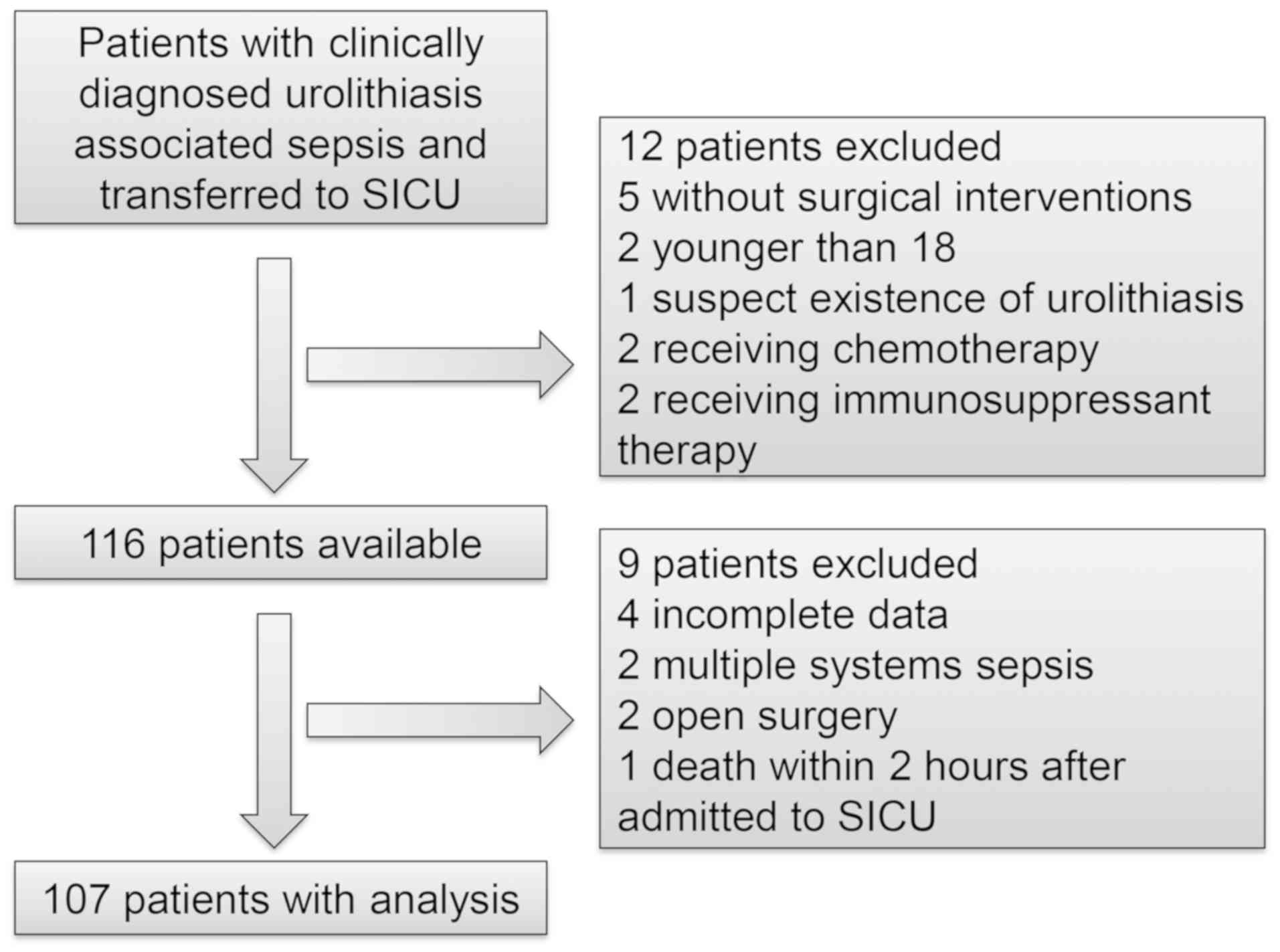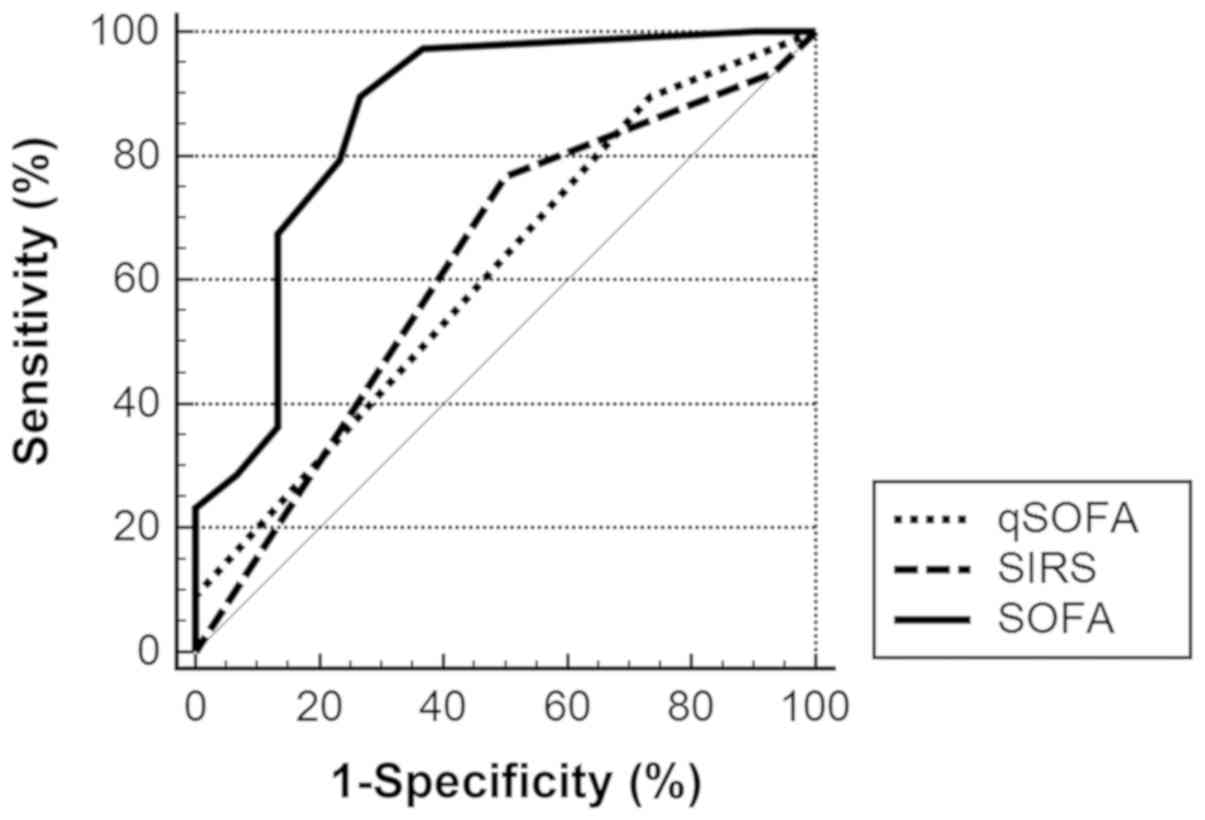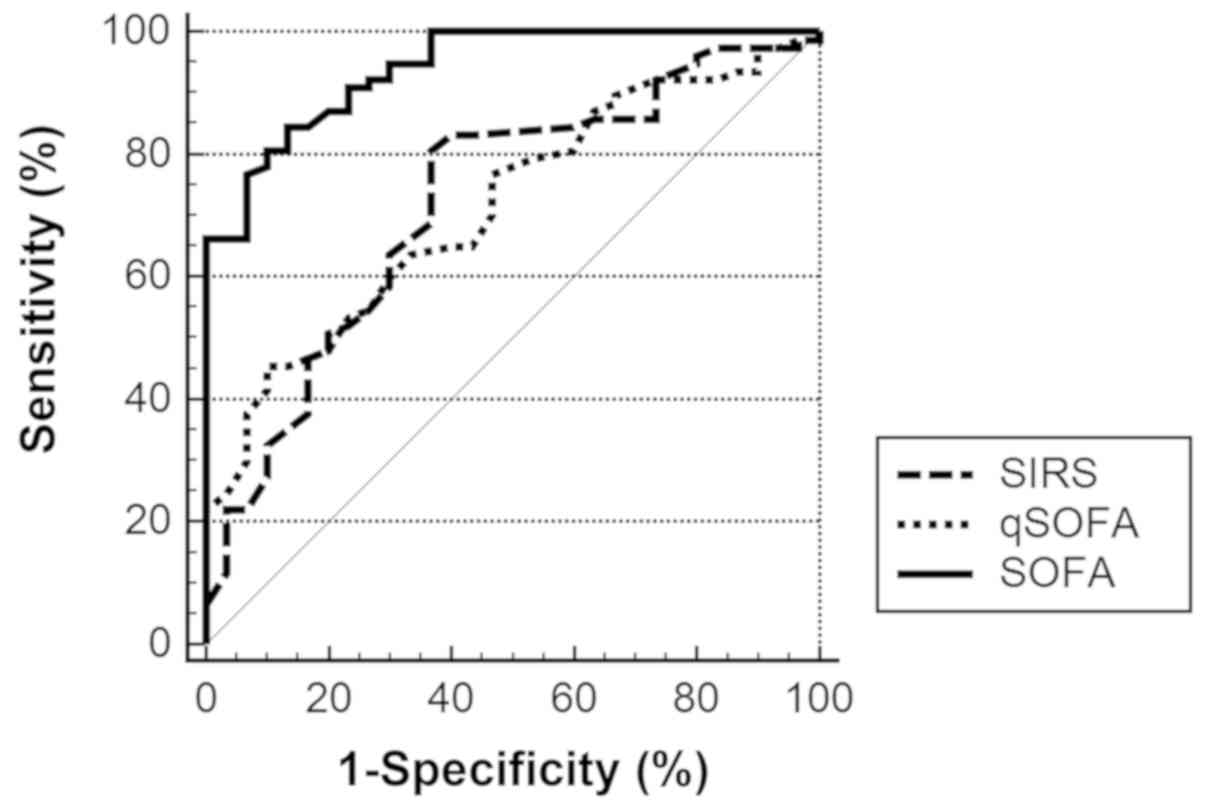|
1
|
Gotts JE and Matthay MA: Sepsis:
Pathophysiology and clinical management. BMJ. 353:i15852016.
View Article : Google Scholar : PubMed/NCBI
|
|
2
|
Cohen J, Vincent JL, Adhikari NK, Machado
FR, Angus DC, Calandra T, Jaton K, Giulieri S, Delaloye J, Opal S,
et al: Sepsis: A roadmap for future research. Lancet Infect Dis.
15:581–614. 2015. View Article : Google Scholar : PubMed/NCBI
|
|
3
|
Singer M, Deutschman CS, Seymour CW,
Shankar-Hari M, Annane D, Bauer M, Bellomo R, Bernard GR, Chiche
JD, Coopersmith CM, et al: The third international consensus
definitions for sepsis and septic shock (Sepsis-3). JAMA.
315:801–810. 2016. View Article : Google Scholar : PubMed/NCBI
|
|
4
|
Shankar-Hari M, Phillips GS, Levy ML,
Seymour CW, Liu VX, Deutschman CS, Angus DC, Rubenfeld GD and
Singer M; Sepsis Definitions Task Force, : Developing a new
definition and assessing new clinical criteria for septic shock:
For the third international consensus definitions for sepsis and
septic shock (Sepsis-3). JAMA. 315:775–787. 2016. View Article : Google Scholar : PubMed/NCBI
|
|
5
|
Seymour CW, Liu VX, Iwashyna TJ,
Brunkhorst FM, Rea TD, Scherag A, Rubenfeld G, Kahn JM,
Shankar-Hari M, Singer M, et al: Assessment of clinical criteria
for sepsis: For the third international consensus definitions for
sepsis and septic shock (Sepsis-3). JAMA. 315:762–774. 2016.
View Article : Google Scholar : PubMed/NCBI
|
|
6
|
Dreger NM, Degener S, Ahmad-Nejad P,
Wöbker G and Roth S: Urosepsis-etiology, diagnosis and treatment.
Dtsch Arztebl Int. 112:837–848. 2015.PubMed/NCBI
|
|
7
|
Wagenlehner FM, Pilatz A, Weidner W and
Naber KG: Urosepsis: Overview of the diagnostic and treatment
challenges. Microbiol Spectr. 32015.doi:
10.1128/microbiolspec.UTI-0003-2012.
|
|
8
|
Wagenlehner FM, Lichtenstern C, Rolfes C,
Mayer K, Uhle F, Weidner W and Weigand MA: Diagnosis and management
for urosepsis. Int J Urol. 20:963–970. 2013.PubMed/NCBI
|
|
9
|
Michel MS, Trojan L and Rassweiler JJ:
Complications in percutaneous nephrolithotomy. Eur Urol.
51:899–906. 2007. View Article : Google Scholar : PubMed/NCBI
|
|
10
|
Koras O, Bozkurt IH, Yonguc T, Degirmenci
T, Arslan B, Gunlusoy B, Aydogdu O and Minareci S: Risk factors for
postoperative infectious complications following percutaneous
nephrolithotomy: A prospective clinical study. Urolithiasis.
43:55–60. 2015. View Article : Google Scholar : PubMed/NCBI
|
|
11
|
Çıtamak B, Altan M, Bozacı AC, Koni A,
Doğan HS, Bilen CY, Şahin A and Tekgül S: Percutaneous
nephrolithotomy in children: 17 Years of experience. J Urol.
195:1082–1087. 2016. View Article : Google Scholar : PubMed/NCBI
|
|
12
|
Wu H, Zhu S, Yu S, Ding G, Xu J, Li T,
Qiao L, Chen Y, Yan J, Cheng X, et al: Early drastic decrease in
white blood count can predict uroseptic shock induced by upper
urinary tract endoscopic lithotripsy: A translational study. J
Urol. 193:2116–2122. 2015. View Article : Google Scholar : PubMed/NCBI
|
|
13
|
Hu M, Zhong X, Cui X, Xu X, Zhang Z, Guan
L, Feng Q, Huang Y and Hu W: Development and validation of a
risk-prediction nomogram for patients with ureteral calculi
associated with urosepsis: A retrospective analysis. PLoS One.
13:e02015152018. View Article : Google Scholar : PubMed/NCBI
|
|
14
|
Freund Y, Lemachatti N, Krastinova E, Van
Laer M, Claessens YE, Avondo A, Occelli C, Feral-Pierssens AL,
Truchot J, Ortega M, et al: Prognostic accuracy of sepsis-3
criteria for in-hospital mortality among patients with suspected
infection presenting to the emergency department. JAMA.
317:301–308. 2017. View Article : Google Scholar : PubMed/NCBI
|
|
15
|
Raith EP, Udy AA, Bailey M, McGloughlin S,
MacIsaac C, Bellomo R and Pilcher DV: Australian and New Zealand
Intensive Care Society (ANZICS) Centre for Outcomes and Resource
Evaluation (CORE): Prognostic accuracy of the SOFA score, SIRS
criteria and qSOFA score for in-hospital mortality among adults
with suspected infection admitted to the intensive care unit. JAMA.
317:290–300. 2017. View Article : Google Scholar : PubMed/NCBI
|
|
16
|
Tokioka F, Okamoto H, Yamazaki A, Itou A
and Ishida T: The prognostic performance of qSOFA for
community-acquired pneumonia. J Intensive Care. 6:462018.
View Article : Google Scholar : PubMed/NCBI
|
|
17
|
Singer AJ, Ng J, Thode HC Jr, Spiegel R
and Weingart S: Quick SOFA scores predict mortality in adult
emergency department patients with and without suspected infection.
Ann Emerg Med. 69:475–479. 2017. View Article : Google Scholar : PubMed/NCBI
|
|
18
|
Park HK, Kim WY, Kim MC, Jung W and Ko BS:
Quick sequential organ failure assessment compared to systemic
inflammatory response syndrome for predicting sepsis in emergency
department. J Crit Care. 42:12–17. 2017. View Article : Google Scholar : PubMed/NCBI
|
|
19
|
Williams JM, Greenslade JH, McKenzie JV,
Chu K, Brown AFT and Lipman J: Systemic inflammatory response
syndrome, quick sequential organ function assessment, and organ
dysfunction: Insights from a prospective database of ED patients
with infection. Chest. 151:586–596. 2017. View Article : Google Scholar : PubMed/NCBI
|
|
20
|
Luo X, Yang X, Li J, Zou G, Lin Y, Qing G,
Yang R, Yao W and Ye X: The procalcitonin/albumin ratio as an early
diagnostic predictor in discriminating urosepsis from patients with
febrile urinary tract infection. Medicine (Baltimore).
97:e110782018. View Article : Google Scholar : PubMed/NCBI
|
|
21
|
Wu H, Wang Z, Zhu S, Rao D, Hu L, Qiao L,
Chen Y, Yan J, Chen X, Wan SP, et al: Uroseptic shock can be
reversed by early intervention based on leukocyte count 2 h
post-operation: Animal model and multicenter clinical cohort study.
Inflammation. 41:1835–1841. 2018. View Article : Google Scholar : PubMed/NCBI
|
|
22
|
Wagenlehner FM, Tandogdu Z and Bjerklund
Johansen TE: An update on classification and management of
urosepsis. Curr Opin Urol. 27:133–137. 2017. View Article : Google Scholar : PubMed/NCBI
|
|
23
|
Türk C, Petřík A, Sarica K, Seitz C,
Skolarikos A, Straub M and Knoll T: EAU guidelines on
interventional treatment for urolithiasis. Eur Urol. 69:475–482.
2016. View Article : Google Scholar : PubMed/NCBI
|
|
24
|
Rhodes A, Evans LE, Alhazzani W, Levy MM,
Antonelli M, Ferrer R, Kumar A, Sevransky JE, Sprung CL, Nunnally
ME, et al: Surviving sepsis campaign: International guidelines for
management of sepsis and septic shock: 2016. Crit Care Med.
45:486–552. 2017. View Article : Google Scholar : PubMed/NCBI
|
|
25
|
Shapiro N, Howell MD, Bates DW, Angus DC,
Ngo L and Talmor D: The association of sepsis syndrome and organ
dysfunction with mortality in emergency department patients with
suspected infection. Ann Emerg Med. 48:583–590.e1. 2006. View Article : Google Scholar : PubMed/NCBI
|
|
26
|
Lindvig KP, Nielsen SL, Henriksen DP,
Jensen TG, Kolmos HJ, Pedersen C, Vinholt PJ and Lassen AT:
Mortality and prognostic factors of patients who have blood
cultures performed in the emergency department: A cohort study. Eur
J Emerg Med. 23:166–172. 2016. View Article : Google Scholar : PubMed/NCBI
|
|
27
|
Finkelsztein EJ, Jones DS, Ma KC, Pabón
MA, Delgado T, Nakahira K, Arbo JE, Berlin DA, Schenck EJ, Choi AM
and Siempos II: Comparison of qSOFA and SIRS for predicting adverse
outcomes of patients with suspicion of sepsis outside the intensive
care unit. Crit Care. 21:732017. View Article : Google Scholar : PubMed/NCBI
|
|
28
|
Ho KM and Lan NS: Combining quick
sequential organ failure assessment with plasma lactate
concentration is comparable to standard sequential organ failure
assessment score in predicting mortality of patients with and
without suspected infection. J Crit Care. 38:1–5. 2017. View Article : Google Scholar : PubMed/NCBI
|
|
29
|
Borofsky MS, Walter D, Shah O, Goldfarb
DS, Mues AC and Makarov DV: Surgical decompression is associated
with decreased mortality in patients with sepsis and ureteral
calculi. J Urol. 189:946–951. 2013. View Article : Google Scholar : PubMed/NCBI
|
|
30
|
de la Rosette J, Denstedt J, Geavlete P,
Keeley F, Matsuda T, Pearle M, Preminger G and Traxer O; CROES URS
Study Group, : The clinical research office of the endourological
society ureteroscopy global study: Indications, complications, and
outcomes in 11,885 patients. J Endourol. 28:131–139. 2014.
View Article : Google Scholar : PubMed/NCBI
|


















